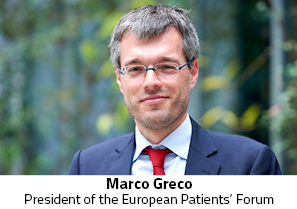17th June 2020
The impact of COVID-19 on people living with non-communicable diseases during the pandemic
The COVID-19 pandemic has hit us somewhat off guard and unprepared. It has ravaged many countries and continues to have a huge impact on our global society. The need to fight the virus has been urgent and all encompassing, and as a result, medical focus has been largely centred on the virus, resulting in the redeployment and prioritisation of scare resources. Healthcare systems across the world have been tirelessly striving to contain the impact on people, and available resources in many countries have therefore been insufficient.

However, before this pandemic hit, Europe was dealing with the significant challenge of delivering care for patients with serious, non-communicable diseases, and we still are. The impact on patients of such diseases do not dissipate in line with our refocus on COVID-19, however pressing that may be.
COVID-19 has shone a harsh light on the unsustainability and weakness of our healthcare systems, and we fear that the impact on already vulnerable populations will be significant and long-lasting.

Take chronic diseases, for example, which affect one-third of the adult population in Europe, and 23.5% of working-age Europeans.1,2 Patients with such conditions are particularly vulnerable to COVID-19, being at higher risk of serious illness and death. Moreover, the disruptions in their healthcare provision caused by the pandemic – treatment delays, discontinuation of routine care services and uncertainty around medicine availability – have left them more at risk than ever.
In the case of cancer and many other diseases, services have been reduced, or put on hold, to protect patients from exposure to the virus, or because non-emergency care has been limited. Diagnosis of new cancers is expected to be significantly delayed, which may have an impact on the success rate of curative and non-curative treatment strategies.
Despite the vast efforts of patient advocacy groups across Europe, the view is that protecting this particularly vulnerable population in many countries has largely been forgotten in the current public discourse. Many patients are facing added uncertainties and concern for their lives as their anxiety grows around how long COVID-19 will continue to negatively impact the care that they are able to access for their condition.
“As a result of this constant fear, I am plagued by stress, anxiety, insomnia, and fatigue, and I hope these will not lead to more aggressive symptoms. This is how the COVID-19 pandemic is affecting my daily life and I hope that other chronic condition patients are not facing a similar scenario.”
–Cassandra Alexis, a Lupus Patient from France.3
“The real challenge is to keep the faith on issues like: are there enough medications available in the long run, can I rely on the continuation of doctor appointments in the hospital?”
–Carine Besselink Berendsen, a Kidney Transplant Patient from The Netherlands.3
Clinical trials are also likely to be delayed or suspended due to the practical challenges of conducting research, which will not only result in a lack of options for patients, but may also signify a setback in the advancement of new medicines and technology.
“We have seen in our melanoma community that our follow-up appointments and control scans are postponed, while patients have been switched to treatments that are less effective but have fewer side effects, can be taken orally instead of intravenously, or are completely taken off treatment. Clinical trials are closed, leaving patients where all other therapies have failed out of options.”
–Bettina Ryll, Member of the EU Cancer Mission Board and Founder of the Melanoma Patient Network, Europe.3
It will take time and data to see the full impact on patients with non-communicable diseases, however this will be by no means trivial. We are already hearing heart-breaking cases of patients who have lost their lives during the pandemic. A recent article published in the Annals of Oncology outlines that even modest delays in surgery for aggressive cancers can have significant impact on survival rates, with a reduction in survival rate of 30% at six months and 17% at three months.4
Despite the enormous pressures placed on our healthcare systems by COVID-19, it is vital that healthcare continues to deliver for patients in need come what may. COVID-19 is indeed a disease that we had not encountered before, but it is not the first time we have had to contend with a highly contagious infectious disease. It does beg the question of how we have left ourselves so exposed. We have seen a lack of crisis preparedness strategy, a lack of aligned containment approaches, and a shortage in vital equipment and supplies.
Policy and provisions for pandemic crisis preparedness are gathering momentum as we learn from our experiences, and groups such as patient organisations and health innovation communities should be at the table alongside other stakeholders when discussions are taking place. It is vital that these voices are heard. Patient organisations are connected to their grass-roots communities and can support healthcare services and governments in developing adequate solutions for patients’ continuing access to care at a time when crisis threatens to overwhelm them. Whereas health innovation can offer solutions to support the continuation of care and connectivity such as with telemedicine for example. In the next pandemic, we must not see essential services so highly compromised.
We must also address the undeniable reality that our healthcare systems are generally unsustainable in their present infrastructural and funding models and see this as an immediate necessity where investment and real weight need to be dedicated at EU and national level. The COVID-19 pandemic has taught us that the uptake of technology can indeed be timely, when there is collective effort motivation and mobilisation from all relevant actors, and it is important to not lose this momentum in agile adoption of technology as we come through the storm, but consider the lessons learned, both good and bad. We need the best user-driven tools at our disposal to protect our healthcare systems, our patients and our citizens.
While COVID-19 has placed us in a period of uncertainty, we must be extremely certain of this – every patient matters and no-one should be left behind.
References
- OECD/European Union (2018), Health at a Glance: Europe 2018: State of Health in the EU Cycle, OECD Publishing, https://doi.org/10.1787/health_glance_eur-2018-en.
- Scaratti, Chiara et al. “Mapping European Welfare Models: State of the Art of Strategies for Professional Integration and Reintegration of Persons with Chronic Diseases.” International journal of environmental research and public health 15,4 https://www.ncbi.nlm.nih.gov/pmc/articles/PMC5923823/. Accessed May 2020.
- European Patients’ Forum. Patient perspectives. eu-patient.eu/COVID-19/patient-perspectives-covid/. Accessed May 2020.
- Annals of Oncology. Collateral damage: the impact on outcomes from cancer surgery of the COVID-19 pandemic, Sud et al. annalsofoncology.org/article/S0923-7534(20)39825-2/fulltext. Accessed May 2020.